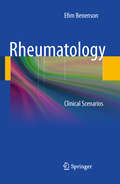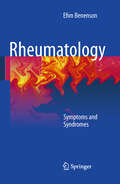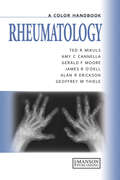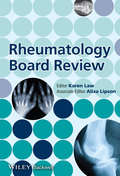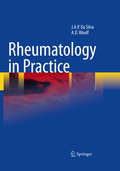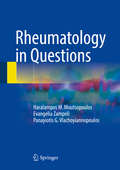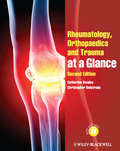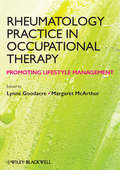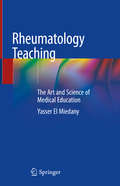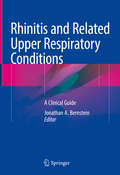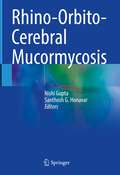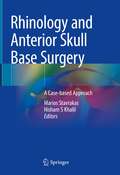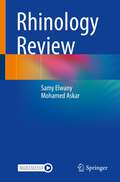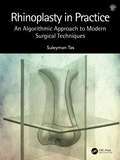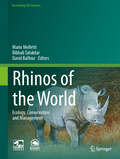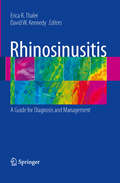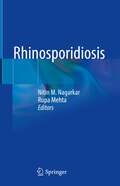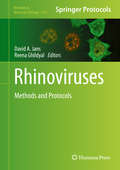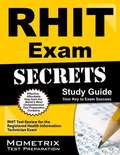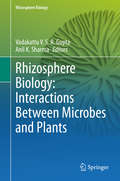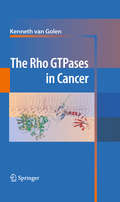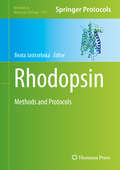- Table View
- List View
Rheumatology: Clinical Scenarios
by Efim BenensonRheumatology: Clinical Scenarios is a case-based learning tool for trainees in rheumatology. Professor Efim Benenson presents 73 clinical scenarios and 156 clinical images for the student of rheumatology to diagnose, whilst his expert commentary is provided in a separate section. As a further diagnostic aid, two 'Rheumatology Trees' are provided which summarize in turn the articular and musculoskeletal disorders, as well as the connective tissue disorders and vasculitides. Professor Benenson's practice-oriented, didactic approach, and innovative organization of the rheumatic diseases is a valuable diagnostic aid to practicing rheumatologists and those teaching or training in rheumatology. <P><P> Readers are recommended the companion book, Rheumatology: Syndromes and Symptoms, for further reading on Professor Benenson's organization of the rheumatic diseases.
Rheumatology: Symptoms and Syndromes
by Efim BenensonRheumatology: Symptoms and Syndromes organizes the rheumatic diseases in the form of syndromes as stable combinations of symptoms, and links these to morphological manifestations. This presentation of the rheumatic diseases provides a pedagogical framework for differential diagnosis in rheumatology. To further aid the teacher and student, Professor Efim Benenson provides algorithms of clinical reasoning based on morphology and pathophysiology. Professor Benenson’s practice-oriented, didactic approach, and innovative organization of the rheumatic diseases is a valuable diagnostic aid to practicing rheumatologists and those teaching or training in rheumatology.<P><P> Readers are recommended the companion book, Rheumatology: Clinical Scenarios, for further reading on Professor Benensons's organization of the rheumatic diseases.
Rheumatology: A Color Handbook (Medical Color Handbook Ser.)
by Ted Mikuls Amy Cannella Gerald Moore James O'Dell Alan Erikson Geoffrey ThieleThis book provides the reader with a complete and concise introduction to rheumatic illness. While rheumatic disease often manifests itself in conditions affecting the musculoskeletal system, the authors stress that a comprehensive multidisciplinary approach is needed for diagnosis, to aid understanding of rheumatic disease with multisystem involve
Rheumatology Board Review
by Karen Law Aliza LipsonThe field encompassed by rheumatology has evolved rapidly over the last decade to include multiple immune-modulating and biologic medications, new classification criteria, significant updates on bone metabolism, and completely new paradigms of treatment based on groundbreaking studies published within the last 5 years. Although much has been adopted as standard of care based on new data, most textbooks do not reflect these practice changes.Rheumatology Board Review highlights the latest advances in the field and new standards of care, including references to current citations in the medical literature. It provides international standards and guidelines and is designed to convey a maximum amount of information quickly and efficiently, with many helpful schematics, radiographs, and tables.Rheumatology Board Review offers chapter coverage of:* Non-inflammatory joint and soft tissue disorders* Selected topics in rheumatoid arthritis* Selected topics in systemic lupus erythematosus* Antiphospholipid antibody syndrome* IgG4-related disease* Myopathies* Selected topics in pediatric rheumatology* HIV and rheumatic diseases* Miscellaneous arthropathies* Osteoporosis* Review of musculoskeletal radiology* Study design, measurement, and basic statistical analysis* Update on vasculitisRheumatology Board Review is a must-have reference for rheumatology fellows and professionals seeking a concise yet thorough review of state-of-the-art rheumatology.
Rheumatology for Primary Care Providers: A Clinical Casebook
by Yousaf AliCurrent texts in rheumatology are very detailed and designed specifically for rheumatologists. This clear and concise guide is targeted at the busy clinician who comes into contact with both common and uncommon rheumatologic disorders. Many chapters presents a common clinical scenario and include a definition of the disease while outlining incidence and prevalence, common manifestations, treatment and pitfalls. A range of topics are included in the fifteen chapters including osteoarthritis, rheumatoid arthritis, fibromyalgia, metabolic bone disease, gout and scleroderma, among others. Written by experts in the field, Rheumatology for Primary Care Providers is a definitive guide to rheumatology for the primary care physician and non-specialist.
Rheumatology in Practice
by Anthony D. Woolf J.A. Pereira SilvaRheumatology in Practice offers chapters which are organised and built around anatomical and regional syndromes, so reinforcing the evidence-based approach. As readers progress through the text they are given more demanding and challenging questions, encouraging them to use their diagnostic skills to identify the main syndromes and the underlying diseases responsible for the disorders in question. The text is lavishly illustrated in full colour, with detailed photos of patient examinations, complemented by radiographs and full colour line illustrations. The text also benefits from the use of summaries using coloured boxing to identify key points in diagnosis and management. Written by two of the most respected clinicians in the discipline, this book will be essential reading for rheumatologists in practice and training.
Rheumatology in Questions
by Haralampos M. Moutsopoulos Evangelia Zampeli Panayiotis G. VlachoyiannopoulosThis book covers all fields in rheumatology and aims to help readers comprehend, familiarize and evaluate their knowledge of the subject area. It contains short questions and concise answers on definitions, pathogenetic aspects, clinical and laboratory manifestations, differential diagnosis and the management of all rheumatic diseases.The book also provides questions and answers on major aspects of basic immunology, valuable for understanding underlying immunological mechanisms of autoimmune rheumatic diseases. Illustrations and images help present information in a clear and schematic way.
Rheumatology, Orthopaedics and Trauma at a Glance (At A Glance Ser.)
by Catherine Swales Christopher BulstrodeRheumatology, Orthopaedics and Trauma at a Glance is the new edition of The Musculoskeletal System at a Glance. The book now includes not just basic anatomy, but also features presenting complaints and patient examination and reflects the increased coverage of rheumatology, making it relevant for students at all levels.Rheumatology, Orthopaedics and Trauma at a GlanceExpands its coverage of rheumatology to include all major topics on the medical student curriculumIncludes fully illustrated chapters on examination of each part of the musculoskeletal systemProvides self-assessment case studies to test knowledge and provide clinical contextConsolidates all information relating to the musculoskeletal system in one titleRheumatology, Orthopaedics and Trauma at a Glance is ideal for all medical students studying the musculoskeletal system or taking an orthopaedics or rheumatology rotation.
Rheumatology Practice in Occupational Therapy
by Lynne Goodacre Margaret McarthurRheumatology Practice in Occupational Therapy is a valuable new handbook focusing on the core area of rheumatology. It provides practical guidance to help occupational therapists treat and manage rheumatic disease in both clinical and community settings and emphasizes a contemporary 'client-centred' approach as a fundamental requirement of effective and rewarding OT practice. Drawing upon personal, clinical and theoretical perspectives, it equips the reader with an understanding not only of relevant practical skills but of the clinical reasoning required to modify and apply these skills to the needs of individual people.
Rheumatology Teaching: The Art and Science of Medical Education
by Yasser El MiedanyThis book provides a comprehensive, state-of-the art overview of medical teaching methodologies with a particular focus on rheumatology. It discusses why teaching medicine requires a review, explains barriers to learning, outlines fresh teaching methods, and includes student-centered learning activities. It introduces novice medical teachers as well as more experienced educators to the exciting new models of medical education, innovative teaching approaches, and challenges they may face whether working in undergraduate, post-graduate, or continuous medical education. Since “Great teachers are made, not born”, this book presents the interactive pattern of the art and science of teaching and serves as a guide to becoming a highly effective medical educator. Rheumatology Teaching: The Art and Science of Medical Education is an essential text for physicians and related professionals who have special interest in medical education and particularly musculoskeletal teaching as well as instructors in nursing, physiotherapy, and physician assistant programs.
Rhinitis and Related Upper Respiratory Conditions: A Clinical Guide
by Jonathan A. BernsteinThis comprehensive book thoroughly covers the spectrum of rhinitis conditions and related comorbidities. Rhinitis and Related Upper Respiratory Conditions is a unique resource that delivers essential clinical information, addressing the varying patient populations which might be encountered in different types of clinical settings. Chapters range from topics such as pediatric, adult, geriatric, and occupational rhinitis, while also covering the full array of rhinitis subtypes and their complications. Later chapters address secondary causes of rhinitis such as systemic diseases manifesting as rhinitis, drug-induced rhinitis, and CSF leak. Written by experts in the field, every chapter is structured to contain clinical cases which illustrate the typical patient presentation, and their diagnostic work-up and treatment, providing the knowledge needed to further improve diagnosis and care for the patient with rhinitis. Rhinitis and Related Upper Respiratory Conditions is an ideal resource for allergists, primary care physicians, and health care extenders, to help them recognize and further improve care of patients with rhinitis.
Rhino-Orbito-Cerebral Mucormycosis
by Nishi Gupta Santhosh G. HonavarThis book is the most comprehensive (and possibly the first) manual on ‘Rhino-Orbito-Cerebral Mucormycosis (ROCM) that covers mucormycosis of the nose extending to sinuses, orbit, and brain, all in. This volume covers the surge of cases during the COVID-19 pandemic, early identification and causative factors, microbiology, pathology and radiology, and the clinical presentation. Notes on surgical approaches, extent, and techniques of debridement, number of sittings, antifungal therapy, complications, and their management equip readers to manage these cases confidently. Detailed descriptions of ROCM surgery accompanied by nearly 500 photographs and anatomical drawings help support diagnostic and surgical decision-making. Also included is information on various specifications of MRI that help in achieving a perfect surgical clearance. The book includes chapters on debates on salvaging the orbit in ROCM, various situations, their management, the extent of resection, antifungal dosage and duration, prognostication of the patient, and postoperative care. The book assists surgeons in gaining the skills to perform endoscopic clearance of difficult areas like pterygoplataine fossa, infratemporal fossa, pterygoid plates, and the lacrimal drainage system, which offers significant advantages in terms of avoiding postoperative morbidity as compared to an external route. Since the external route is required in the most extensive form of the disease, the book has also covered it extensively. This book is an indispensable resource for otorhinolaryngologists, ophthalmic surgeons, ophthalmic plastic surgeons, physicians, microbiologists, pathologists, radiologists, neurosurgeons, faciomaxillary surgeons and junior and senior consultants optometrists and students.
Rhinology and Anterior Skull Base Surgery: A Case-based Approach
by Marios Stavrakas Hisham S KhalilThis book offers a selection of pertinent patient case-presentations in the field of rhinology, anterior skull base and facial plastics surgery. It further explores the evidence-based management of simple to complex clinical presentations. Each chapter start with the diagnosis and progresses from medical or surgical treatment to the post-operative follow up of the presented clinical condition. The various case reports are concise; however, sufficiently comprehensive and cover conditions from emergencies in adult and paediatric rhinology, to elective care, sino-nasal and anterior skull base neoplasms systemic diseases affecting the nose and paranasal sinuses, and underpinned by illustrations, imaging, and intra-operative photographs to emphasize the clinical approach. Rhinology and Anterior Skull Base Surgery - A Case-based Approach is a highly informative and carefully presented book, providing insights for exam candidates, trainees, general practitioners, rhinologists and otolaryngologists with an interest in anterior skull base, facial plastics and rhinology.
Rhinology Review
by Samy Elwany Mohamed Askar<p>The book presents the full range of topics in the modern rhinology syllabus: from basic sciences of rhinology and investigative rhinology, through rhinologic symptoms and diseases, to office procedures and operations. The volume covers also related important areas that may be encountered in today’s exams like the basics of rhinoplasty and anterior skull surgery.<p> <p>Each chapter distils key facts into bullet points for rapid access to essential information. Supplemented by diagrams, charts, illustrative radiographs and endoscopic pictures, the topics addressed are followed by MCQs and their answers.<p> <p>The volume will serve as a concise and to-the-point resource for postgraduates preparing for their fellowship, board and similar exams. Experienced otolaryngologists may also use it as a compact reference and a refresher in their day to day practice.<p>
Rhinoplasty: An Atlas Of Surgical Techniques
by Rollin K. Daniel Péter PálháziIn this atlas, sequential anatomical dissections are presented which show each component of the nose in unprecedented meticulous detail. Anatomical photographs are often paired with anatomical drawings and even intraoperative clinical photographs to illustrate each part of the nose. Rhinoplasty: An Anatomical and Clinical Atlas, provides an in-depth understanding of nasal anatomy and a wide variety of operative techniques. In rhinoplasty surgery, the surgeon must understand the tight linkage between surface aesthetics, underlying anatomy, and selection of operative techniques. The underlying anatomy is only revealed to a limited degree at the time of surgery and the surgeon must then adapt the operative plan to fit the actual anatomy observed in the operating room to achieve the patient’s desired aesthetic result. Ultimately, the goal of this atlas is to allow the surgeon to see the operative techniques in both cadavers and clinical cases which represents the best possible learning approach.
Rhinoplasty in Practice: An Algorithmic Approach to Modern Surgical Techniques
by Suleyman TasThis book will enable the reader, regardless of their experience, to master the best rhinoplasty practice. It includes all contemporary techniques such as preservation, structural, and atraumatic rhinoplasty concepts, and makes them very practical to apply. Rhinoplasty in Practice not only explains the anatomy, historical evaluations, philosophy, descriptions, indications, limitations, and complications of rhinoplasty but also reports many innovative and unpublished data, tips, and tricks for success. The text is enhanced by: Algorithms and tables for a clear understanding of the deformity and treatment techniques Almost 100 full HD surgical and 3D animation videos (available via a Companion Website) to make the techniques clear, practical, and applicable Over 500 superb illustrations to make the anatomy and surgical techniques more easily comprehensible, allowing the reader to follow each step and including cadaver, histological, ultrasonography, computed tomography, and clinical studies
Rhinos of the World: Ecology, Conservation and Management (Fascinating Life Sciences)
by Mario Melletti Bibhab Talukdar David BalfourThis book represents the culmination of more than four years of work by many rhino experts, primarily from Africa, Asia, the United States, and Europe, involved in rhino conservation, research and management. It is one of the most comprehensive reference works ever published on the systematics, ecology, conservation status, and management of all rhinoceros species. Covering all five rhino species worldwide, this volume brings together the contributions of 92 international rhino experts and provides: A comprehensive overview of the current state of knowledge on the evolution, phylogeny, systematics, and fossil record of rhinos An in-depth look at the ecology and conservation status of each species, with detailed chapters A series of case studies on conservation management, poaching, horn trade, and ex-situ programs. This beautifully illustrated book is an invaluable resource for researchers, wildlife managers and professionals in conservation biology, ecology, and management, as well as the general public. It reveals the fascinating story of rhino evolution, the long history of human interactions with rhinos, and the major threats to these iconic species.
Rhinosinusitis
by Erica Thaler David W. KennedyRhinosinusitis is one of the most common health care complaints, with many millions of cases managed annually by a variety of practitioners, from family care physicians and pediatricians to allergists, pulmonologists, and otolaryngologists. Rhinosinusitis: A Guide for Diagnosis and Management provides a comprehensive, practical guide to treating this widespread condition. Medical, surgical, and pharmacological management of both acute and chronic forms are discussed by experts with a wealth of clinical experience. Pediatric considerations and the role of allergies, asthma, and systemic diseases such as cystic fibrosis are discussed. A special chapter is devoted to alternative medicine in recognition of its increasing role in health care management. Diagnostic imaging techniques such as MRI and CT are discussed in detail. Finally, adjunctive surgical therapies are reviewed. Written for both primary care physicians and specialists, this guide will serve as an invaluable quick reference.
Rhinosporidiosis
by Nitin M. Nagarkar Rupa MehtaThis textbook covers all aspects of rhinosporidiosis known till date and puts forward the various aspects of the disease on which further research can be carried out. Detailed descriptions of varied presentations of rhinosporidiosis managed at our institute is provided, accompanied by numerous clinical and intraoperative photographs. This book will serve as a comprehensive source of information related to all aspects of rhinoporidiosis. Experts from multiple specialties have contributed about aspects pertaining to their specialties.
Rhinovirus: Methods and Protocols (Methods in Molecular Biology #2903)
by Umadevi SajjanThis volume details methods to detect Rhinovirus (RV) in clinical samples, propagation and purification of virus, in vivo and in vitro model systems, and the newer molecular tools that are useful for the studying the RV infection and pathogenesis. Chapters guide readers through a greater of understanding of RV pathogenesis in COPD, childhood asthma development and protective innate immunity. However, there is much to learn about RV infection in order to develop therapies to treat asthma and COPD exacerbations, prevent development of asthma and treat common colds. Written in the highly successful Methods in Molecular Biology series format, chapters include introductions to their respective topics, lists of the necessary materials and reagents, step-by-step, readily reproducible laboratory protocols, and key tips on troubleshooting and avoiding known pitfalls. Authoritative and cutting-edge, Rhinovirus: Methods and Protocols aims to be a useful and practical guide to new researchers and experts looking to expand their knowledge.
Rhinoviruses
by David A. Jans Reena GhildyalRhinoviruses: Methods and Protocols highlights the numerous molecular, cellular and in vivo tools now available to conduct human rhinovirus (HRV) research in an effort to increase understanding of the clinical disease caused by HRVs as well as the functions of its individual proteins and its replication. Human rhinoviruses are the major cause of common colds as well as being more recently recognized as the major viral cause of asthma and chronic obstructive pulmonary disease (COPD) exacerbations. The huge advancements in technical applications of biophysics and improvements in high-end imaging techniques have also had implications for HRV research among other infectious diseases. Written in the successful Methods in Molecular Biology series format, chapters include introductions to their respective topics, lists of the necessary materials and reagents, step-by-step, readily reproducible protocols, and notes on troubleshooting and avoiding known pitfalls. Authoritative and easily accessible, Rhinoviruses: Methods and Protocols seeks to serve both professionals and novices with the latest technical advances in HRV research to ultimately enable the development of therapeutic approaches to combat HRV, and most importantly, its pathogenic effects in asthma exacerbation.
RHIT Exam Secrets Study Guide
by Mometrix Exam Secrets Test Prep Team***Includes Practice Test Questions*** RHIT Exam Secrets helps you ace the Registered Health Information Technician Exam without weeks and months of endless studying.
Rhizosphere Biology: Interactions Between Microbes and Plants (Rhizosphere Biology)
by Anil K. Sharma Vadakattu V. S. R. GuptaThis book presents a detailed discussion on the direct interactions of plants and microorganisms in the rhizosphere environment. It includes fifteen chapters, each focusing on a specific component of plant-microbe interactions, such as the influence of plants on the root microbiome, and the downstream effects of rhizosphere microbial dynamics on carbon and nutrient fluxes in the surroundings. As such, the book helps readers gain a better understanding of diversity above the ground, and its effect on the microbiome and its functionality.
The Rho GTPases in Cancer
by Kenneth Van GolenThe Rho GTPases were first discovered due to their homology to Ras GTPase. Approximately 30% of human cancers harbor an activating mutation to Ras, and Ras mutations promote cell growth and survival. Due to their homology to Ras, great enthusiasm has ensued over the discovery of the Rho GTPases. It was thought that activating mutations, similar to what is seen in Ras, would be found in the Rho proteins and would account for a proportion of human cancers that did not harbor Ras mutations. After an intense survey of multiple human cancer specimens, no evidence of activating mutations were found. Instead, overexpression of Rho proteins and aberrant activation were found to be common. Aberrant activation of Rho GTPase is found to be caused by alterations in the activity of upstream Rho-regulatory proteins. Since their discovery, 22 human Rho proteins have been identified and several have been shown to be involved in cancer progression. In contrast to Ras and its closely related members, Rho proteins act as dynamic switches to alter the actin cytoskeleton. Because of this, these proteins regulate nearly all aspects of cell physiology including growth, polarity and migration. Thus, they are very important molecules in cancer biology and constitute potential and desirable therapeutic targets. The roles and importance of the Rho GTPases in cancer is just really becoming to be appreciated and the amount of new information gathered over the past 5 years has been staggering. However, there currently is no comprehensive source of information for Rho biology. Therefore, this volume could be very timely and of great interest.
Rhodopsin
by Beata JastrzebskaThis volume explores the technological improvements in protein engineering, expression, purification, and crystallization of several rhodopsin photoactive intermediates, thus increasing our understanding of rhodopsin activation. The first chapters of the book focus on methods developed to study fundamentals of rhodopsin structure and function, starting with improved purification protocols of native and mutated rhodopsin, followed by methods used for rhodopsin reconstitution into lipid bilayers stabilizing rhodopsin function properties, and finally describing recently developed methods to study structural dynamics of rhodopsin activation and its mechanistic properties. Subsequently, chapters underline various techniques that have been developed to visualize the rhodopsin dimer and to study its functional significance. The next few chapters highlight cutting-edge imaging techniques of photoreceptors, rhodopsin trafficking, and its diffusion within signaling membranes. Finally the book concludes with recent developments that could be potentially beneficial in patient treatments, and treatment strategies for retinal degenerative diseases. Written in the highly successful Methods in Molecular Biology series format, the chapters include the kind of detailed description and implementation advice that is crucial for getting optimal results in the laboratory. Timely and practical, Rhodopsin: Methods and Protocols reaches out to researchers and health practitioners, and provides timely protocol useful for studying structural and functional properties of rhodopsin.
